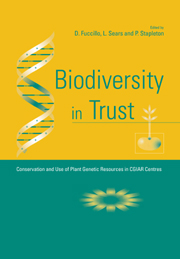Book contents
- Frontmatter
- Contents
- Preface
- Contributors
- Acronyms
- Chapter 1 Cassava
- Chapter 2 The Potato
- Chapter 3 Sweetpotato
- Chapter 4 Other Andean Roots and Tubers
- Chapter 5 Yams
- Chapter 6 Banana and Plantain
- Chapter 7 Cowpea
- Chapter 8 Chickpea
- Chapter 9 Groundnut
- Chapter 10 Lentil
- Chapter 11 Phaseolus Beans
- Chapter 12 Pigeonpea
- Chapter 13 Faba Bean
- Chapter 14 Soyabean
- Chapter 15 Barley
- Chapter 16 Maize, Tripsacum and Teosinte
- Chapter 17 Pearl Millet
- Chapter 18 Small Millets
- Chapter 19 Rice
- Chapter 20 Sorghum
- Chapter 21 Wheat
- Chapter 22 Forages
- Index
Chapter 3 - Sweetpotato
Published online by Cambridge University Press: 22 September 2009
- Frontmatter
- Contents
- Preface
- Contributors
- Acronyms
- Chapter 1 Cassava
- Chapter 2 The Potato
- Chapter 3 Sweetpotato
- Chapter 4 Other Andean Roots and Tubers
- Chapter 5 Yams
- Chapter 6 Banana and Plantain
- Chapter 7 Cowpea
- Chapter 8 Chickpea
- Chapter 9 Groundnut
- Chapter 10 Lentil
- Chapter 11 Phaseolus Beans
- Chapter 12 Pigeonpea
- Chapter 13 Faba Bean
- Chapter 14 Soyabean
- Chapter 15 Barley
- Chapter 16 Maize, Tripsacum and Teosinte
- Chapter 17 Pearl Millet
- Chapter 18 Small Millets
- Chapter 19 Rice
- Chapter 20 Sorghum
- Chapter 21 Wheat
- Chapter 22 Forages
- Index
Summary
The sweetpotato belongs to a single species, Ipomoea batatas (L.) Lam. In Spanish, the most common names are batata, camote and boniato; in French, patate douce; in Portuguese, batata doce; in Italian, batata dolce; in Chinese, gan shu, and in Quechua, the Inca language, kumara or apichu. In the United States, the deep orange, moist-fleshed cultivars are sometimes mistakenly called yam, which belongs to the totally different genus Dioscorea.
Sweetpotato is the world's seventh most important food crop after wheat, rice, maize, potato, barley and cassava. It is grown in more developing countries than any other root crop. World sweetpotato production is around 124 million t in an area of about 9.2 million ha.
BOTANY AND DISTRIBUTION
The sweetpotato and the wild species closely related to it are classified in the family Convolvulaceae, genus Ipomoea, subgenus Eriospermum, section Eriospermum (formerly Batatas) and series Batatas (Austin and Huamán 1996).
Linnaeus described the cultivated sweetpotato in 1753 as Convolvulus batatas. In 1791, the botanist Lamarck described it as Ipomoea batatas. It is a hexaploid plant with 2n=6x=90 chromosomes, although some plants morphologically quite similar to I. batatas with 2n=4x=60 have been described and named, but they are considered synonyms of this species (Austin 1977).
Origin, Distribution and Diffusion
Abundant evidence shows that sweetpotato was spread widely through the migration routes of people in the New World tropics before the discovery of America.
- Type
- Chapter
- Information
- Biodiversity in TrustConservation and Use of Plant Genetic Resources in CGIAR Centres, pp. 29 - 38Publisher: Cambridge University PressPrint publication year: 1997
- 9
- Cited by

